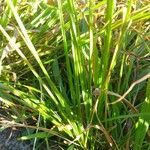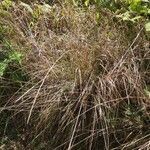Perennials, erect, caespitose. Flowering culms 15–90 cm high. Leaves: basal leaf sheath margins glabrous; ligule a ciliate membrane, to 0.3 mm long; blade involute, linear, 6–18 cm long, 1–3 mm wide, with smooth margins. Inflorescences linear, contracted and spiciform, 6–20 cm long; primary branches solitary, equalling or longer than adjacent internodes, appressed uniformly to axis, spikelet-bearing throughout, with spikelets loosely spaced and fairly even. Spikelets shortly pedicellate or subsessile, 2.1–2.5 mm long. Glumes: lower glume elliptic or lanceolate, 0.5–0.9 mm long, obtuse, without nerves; upper glume lanceolate, at least half spikelet length, to 1.5 mm long. Lemma elliptic, 1.5–1.8 mm long, acute, 1-nerved. Palea slightly shorter than lemma, entire. Anthers 3, to 0.9 mm long. Grain oblong, quadrangular, 1.1–1.3 mm long, to 0.6 mm wide, to 0.5 mm thick, reticulate, dark brown. Embryo less than half as long as grain.
Tufted perennial, the basal sheaths rather broad and somewhat papery; culms 30–110 cm. high, 1.5–3 mm. in diameter at the base.. Leaf-blades flat or convolute, up to 40 cm. long, 1–4 mm. wide, tapering to a long filiform tip.. Panicle linear with short side branches to spiciform, 10–35 cm. long, dense; primary branches appressed to the main axis, subsecund, densely spiculate along their whole length, the lowest 1–2 cm. long.. Spikelets (1.5–)2.1–2.8 mm. long, dark green; lower glume broadly oblong, 0.4–0.7 mm. long, hyaline, obtuse; upper glume narrowly ovate, 1–1.5 mm. long, ± 1/2 as long as the spikelet, acute; lemma ovate-elliptic, as long as the spikelet, acute; anthers 3, 0.6–0.8 mm. long.. Grain ellipsoid, (0.8–)1.1– 1.2 mm. long, truncate at the top, often ± tetragonal in cross-section.
Tufted perennial, 0.28-1.50 m high; rhizomatous. Leaf blade 200-400 x 1-4 mm; ligule a fringed membrane or a fringe of hairs. Inflorescence a dense panicle, almost spike-like; branches not whorled, relatively short and rigid, central axis usually visible. Spikelets 2.0-2.8 mm long, laterally compressed, awnless, glabrous, disarticulating above glumes; glumes 1-nerved; lower glume 1/4-1/2 as long as spikelet; upper glume 1/2 spikelet length. Floret 1; lemma similar in texture to glumes, membranous, often shining, 1-3-nerved. Flowering time Oct.-Apr. Caryopsis ellipsoid, 1.1-1.2 mm long.
Tufted perennial 280-1500 mm high; rhizomatous. Leaf blade 200-400 x 1-4 mm. Inflorescence dense, almost spike-like, branches not whorled, relatively short, rigid, central axis usually visible. Spikelet 2.0-2.8 mm long; glumes unequal; lower glume 1/4-1/2 as long as spikelet, broadly oblong, apex obtuse, nerveless; upper glume 1/2 the spikelet length, narrowly ovate, apex acute; lemma ovate-elliptic, apex acute; grain ellipsoid, 1.1-1.2 mm long; anther 0.8-1.0 mm long.
Spikelets 1.7–2.6 mm long, greyish-green to dark green; inferior glume 1/5–2/5 the length of the spikelet, broadly oblong, hyaline, nerveless, glabrous, obtuse at the apex; superior glume 2/5–3/5 the length of the spikelet, narrowly ovate, hyaline, 1-nerved, glabrous, acute at the apex; lemma as long as the spikelet, ovate-elliptic, acute; anthers 3, 0.6–1.2 mm long.
Perennial, rhizomatous and tufted, up to 1.5 m high. Leaf blades 200-400 mm long, 1-4 mm wide. Spikelets 2.0-2.8 mm long. Panicle dense, not whorled, almost spike-like, branches relatively short and rigid, central axis usually visible; lower glume a quarter to half the spikelet length; upper glume half the spikelet length; grain ellipsoid, 1.1-1.2 mm long.
Perennial; up to 1.5 m high; rhizomatous; tufted. Leaf blades 200-400 x 1-4 mm. Flowers: panicle dense; not whorled; almost spike-like; branches relatively short and rigid; central axis usually visible; spikelets 2.0-2.8 mm long; lower glume 1/4-1/2 spikelet length; upper glume 1/2 spikelet length; caryopsis ellipsoid; 1.1-1.2 mm long.
Caespitose perennial without rhizomes or stolons; culms up to 130 cm tall, erect, unbranched; basal leaf sheaths broad, chartaceous, glabrous, laterally compressed, persistent; leaf laminas up to 40 cm × 1–4 mm, flat or involute, glabrous or scaberulous on the surfaces, thinly scabrid on the margins, tapering to a long filiform apex.
Panicle (10)20–45 cm long, linear to spiciform; primary branches not in whorls, appressed to the main axis 1–2 cm long, thinly scabrid, eglandular, subsecund, the spikelets densely arranged along their whole length.
A grass. It is densely tufted and wiry. It grows 60-100 cm high. The leaf blade is 40 cm long by 1-4 mm wide. The flowering shoot is like a dense spike with very small spikelets. They are less than 2.5 cm long.
Perennial to 1 m. Leaves linear. Spikelets 2.0-2.8 mm long, in a dense, narrow, ± spike-like panicle, branches short and rigid, not obscuring central axis, glume up to half as long as spikelet.
Grain (0.8)1–1.2 mm long, elliptic to obovate, truncate at the top, tetragonal in section.
Perennial, up to about 60 cm. high


